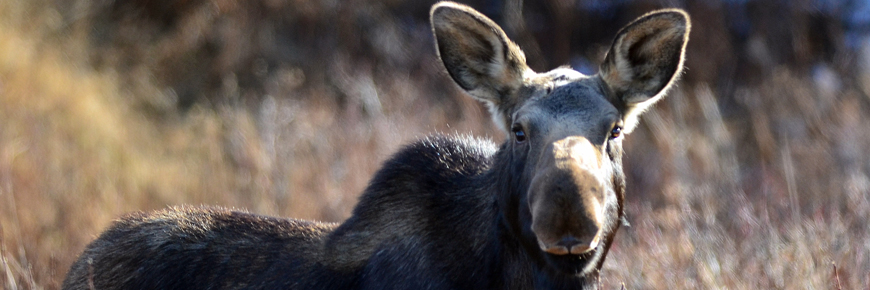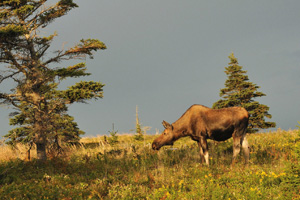
Moose
Fundy National Park
The moose is the largest mammal in Fundy National Park and is an important component of the Acadian forest ecosystem.

The moose is the world's largest living deer, standing almost two metres at the shoulder. It is characterized by its large size, long face with overhanging muzzle, dewlap or 'bell' under the throat, long legs and short tail. The moose is usually dark brown to black, with beige or gray lower legs. The moose is most active at night but can be seen any time of day. It eats non-grass herbaceous plants in the summer and the bark, twigs and buds of woody plants in the winter.
In Fundy national park, the moose is one of the indicators of the health of the forest ecosystem; they are such a large animal and they can eat so much vegetation that they can eat can be a driver of the health of the forest ecosystem. In Fundy, the moose population is monitored through aerial surveying, and they are more often encountered in upland areas (for example the area in the western/northern sections of the park), and much less often near the coast.
The male moose, or bull, has large, palmate antlers. They drop their antlers in the fall after the mating season, and re-grow them over three to five months in the spring and summer.
The female, or cow, moose gives birth to one or two calves in May to June. A moose can live up to 20 years in the wild.
Distribution
Moose are circumpolar, living in the boreal forests throughout the northern hemisphere. In North America, they may be found across Canada and the northern parts of the United States. Canada is home to four subspecies of moose:
- Eastern moose, found from western Ontario to the Atlantic provinces
- Western moose, found from British Columbia to western Ontario
- Alaska moose, found in western Yukon
- Shiras moose, found in the Rocky Mountains in southern Alberta and British Columbia
Related links
- Date modified :